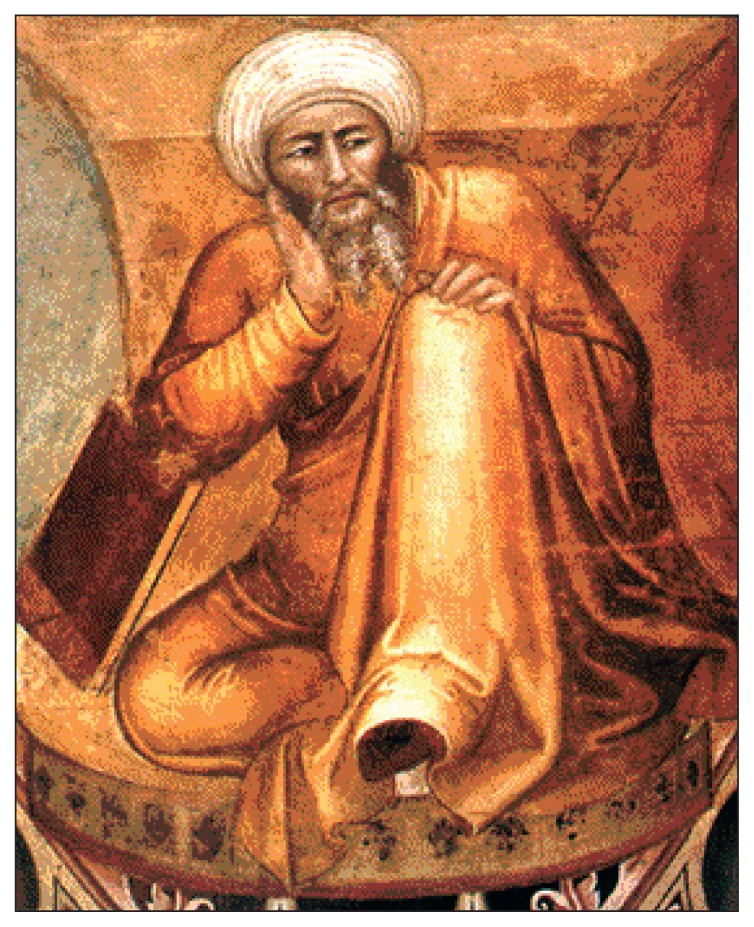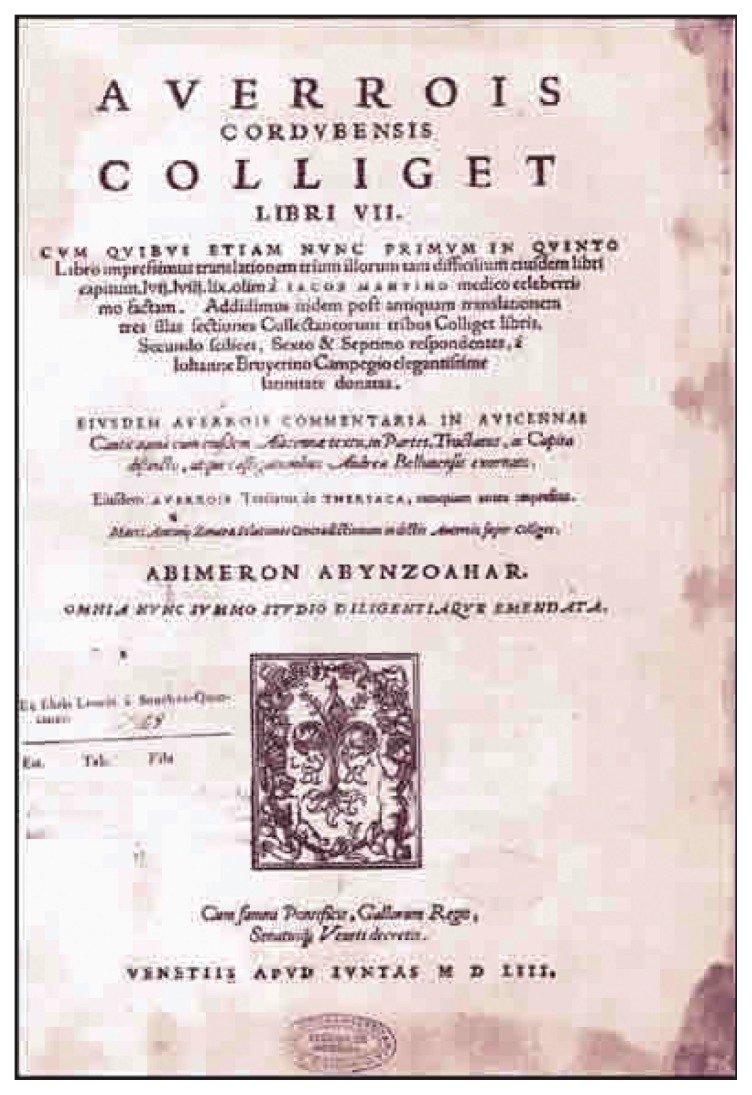Abu Al- Walid Muhammad Ibn Ahmad Ibn Muhammad Ibn Rushd, known in the West as Averroës or Avén Ruiz or Averrhoes, was born in 1126 A.D. in Cordova (once the capital of Moorish Spain), and died in Marrakech, Morocco (Capital of the Almohad or al-Muwahhidun dynasty) on December, 10, 1198 A.D. Akin to many Arab and Muslim physicians and scholars we discussed in this series,1–6 Ibn Rushd was a true polymath, with knowledge, expertise and genuine contributions to philosophy, islamic law (jurisprudence), medicine, astronomy, mathematics, physics and geography. Not surprisingly, he became known as the “Prince of Science”.
Ibn Rushd was a descendent of distinguished family of scholars, excelling in Quranic studies and theology, and with a long and well-respected tradition of legal and public service. Ibn Rushd is sometimes referred to the grandson (Al-Hafid), since his grandfather who carried the same name, used to be the grand judge (Qadi) of Cordoba. Ibn Rushd (the grandfather) was the author of a famous treatise in Maliki jurisprudence, the kitab al-Mugad Dimat al Mumahhidat. Ibn Rushd’s father, Abu Al-Qasim Ahmad was also a Qadi.7
It was Ibn Tufail (Abubacer), the philosophic vizier of Almohad Caliph Abu Yaqub Yusuf, who introduced Ibn Rushd to the court. In 1169 A.D., Ibn Rushd was appointed a judge in Seville and in 1171 A.D., he was transferred to Cordova, where he held the position of a judge (Qadi) for ten years. During that time, he wrote commentaries and interpretations on the works of Aristotle, among others on Metaphysics, and on Plato’s Politeia. In 1182 A.D., he was called to Marrakesh to work as a personal physician for the Caliph there, but he was soon transferred back to Cordova with the title of Great Qadi (Chief Judge). Ibn Rushd fell out of favor with the Caliph due to the opposition that theologians had raised against his writings. He was accused of heresy, interrogated and banned to Lucena, close to Cordova. At the same time (1195 A.D.), the Caliph ordered the books of Ibn Rushd to be burnt, with the exception of his works on medicine, arithmetic and elementary astronomy. Sometime later, the Caliph revoked the banishment and called Ibn Rushd back to Marrakesh.
Ibn Rushd’s Work
Ibn Rushd loved books. It is said that he never missed reading or writing except the day he got married and the day his father died. Therefore, it is not surprising that he was prolific and encyclopedic author. Ibn Rushd’s writings spread more than 20,000 pages, the most famous of which deal with philosophy, medicine, logic and jurisprudence. He wrote 20 books on medicine. His work includes:
-
Tahfut at Tahafut (The Incoherence of the Incoherence): It was written in the style of a dialogue against al-Ghazali’s claims in Tahafut alfalasifa (The Incoherence of the Philosophers).
Ibn Rushd in a detail of Triunfo de Santo Tomas, 14th century florentine artist Andrea Bonaiuto. Talkis Kitab al-Jadal (Middle Commentary on Aristotle’s Topics)
Fasl al-Maqal Fi Ma bayn al-Sharia wa Al-Hukma Min Al-Ittisal (Faith & Reason)
Al-Kashf ‘an manahij al-’adla fi ‘aqaid al-mila (Clarifying the systems of proof in the beliefs of the nation {Muslims}).
Al-Da’ruri fi Isul al-Fiqh: a summary of al-Ghazali’s Mustasfa.
Bidāyat al-Mujtahid wa Nihāyat al-Muqta_id: a textbook of Maliki doctrine in a comparative framework
Al-Bayān wa’l-Ta__īl, wa’l-Shar_ wa’l-Tawjīh wa’l-Ta’līl fi Masā’il al-Mustakhraja: a long and detailed commentary based on the Mustakhraja of Mu_ammad al-’Utbī al-Qurtubī.
Kulliyat Fi A-Tibb (“Generalities”, i.e. general medicine): known in its Latin translation as Colliget.
A commentary on The Canon of Medicine (Qanun fi ‘t-tibb) of Ibn Sina (Avicenna) (980–1037).
Maqala fi ‘1-Tiryaq (“Treatise on Theriac”).
Averroes on Plato’s Republic.7
Front page of a Latin translation of the Ibn Rushd book on medicine, “Kitab al Kulliyat” known in Europe as “Colliget”.
Ibn Rushd the Philosopher and Theologian
Ibn Rushd greatly admired Aristotle and considered him a giant who had attained the truth. He regarded Aristotle as embodying the highest development of the human intellect. It is said that Ibn Rushd understood, and interpreted and analytically discussed Aristotle’s philosophy more than any of his predecessors or contemporaries. Ibn Rushd maintained that the deepest truths must be approached by means of rational analysis and that philosophy could lead to the final truth. He accepted revelation, and attempted to harmonize religion with philosophy without amalgamating them or eradicating their differences. He believed the Qur’an contained the highest truth while maintaining that its words should not be taken literally. He argued that philosophy confirms and does not contradict the revelation. He contended that philosophy is nothing more than the systematic probing into the phenomenon of creation, revealing God’s wisdom and might. Hence, revelation dictates the study of philosophy.
In the Muslim world, Ibn Rushd is known above all for his Tahfut at Tahafut (The Incoherence of the Incoherence) and Mabâdi ‘l-Falâsifah (The Principles of Philosophy). In Tahfut at Tahafut, Ibn Rushd bitterly attacked Al-Ghazili’s Tahafut al-falasifa (The Incoherence of the Philosophers), a work in which the 12th century theologian Al-Ghazali sought a strengthening of piety by attacking the philosophers. Ibn Rushd, point by point, discussed the “alleged” errors in al-Ghazali’s views and methodology. He affirmed that the evidence brought out by al-Ghazali’s attack on philosophers arises when isolated components of philosophy are taken out of context, appearing to contradict the remainder.
Ibn Rushd the Physician
The philosophical, religious and legal works of Ibn Rusd have been studied more thoroughly than his medical books. Among his mentors in medicine were Ali Abu Ja’far Ibn harun al-Tarrajani and Abu marwan Ibn Jurrayul (or Hazbul, according to al-Safadi).8 His important contribution to medicine was “Al- Kulliyat fi Al-Tibb” (Colliget or “ Generalities on Medicine”), which was written between 1153 and 1169. The Colliget was translated to Hebrew and Latin 90 years later and taught in Europe until the 18th century. This treaty is a summary of the medical science at that time and is subdivided into seven books:8
Tashrih al-a’lda’ (“Anatomy of Qrgans”),
al-Sihha (“Health”),
al-Marad (“Sickness”),
al-’Alamat (“Symptoms”),
al-Adwiya wa ‘l-aghdhiya (“Drugs and Foods”),
Hifz al-sihha (“Hygiene”), and
Shifa al-amrad (“Therapy”)
Ibn Rushd was very much interested in anatomy. He stated that the “practice of dissection strengthens the faith” due to his view of the human body as “the remarkable handiwork of God in his creation.”9 In neurology and neuroscience, Ibn Rushd suggested the existence of Parkinson’s disease and attributed photoreceptor properties to the retina.10 Ibn Rushd’s views on retinal sensitivity and ocular functions are addressed in several publications.11–13 Ibn Rushd’s work on stroke complemented the work of Al-Razi and Ibn Sina in replacing the fairly simple model handed down by Galenists of the Byzantine period by more detailed classifications, which proposed “cerebral” as well as “vascular” origins of the disease without suggesting a “cerebrovascular” etiology.14 In urology, he identified the issues of sexual and erectile dysfunction, and was among the first to prescribe medication for the treatment of these problems. He used several methods of therapy for this issue, including the single drug method where a tested drug is prescribed, and a “combination method of either a drug or food.” Most of these drugs were oral medication, though a few patients were also treated through topical or transurethral means.15 Averroes examined the nature, quality and utilization of theriac as an antidote of poisons or venoms and as a treatment of diseases. He stated that if the electuary, as antidote, was beneficial to the patient and to the physician, it might be dangerous as a regular and repeated medication of disease since it could transform the human nature and render it poison-like.16
Ibn Rushd requested his close friend Ibn Zuhr (Avensoar, 1091–1161 A.D.) to write a book on al-Umur al-juz’iyya (particularities, i.e., the treatment of head-to-toe diseases), which he did, and called his book al-Taisir fi ‘l-muddawat wa ‘l-tadbir (“An Aid to Therapy and Regimen”). Ibn Rushd’s al-Kulliyyat and Ibn Zuhr’s al-Taisir were meant to constitute a comprehensive medical textbook. (hence certain printed Latin editions present these two books together and attributes both to Ibn Rushd).8 Ibn Rushd showed interest in Ibn Sina’s Urjuza fi ‘I-tibb (“Poem on Medicine,” Canticum de medicina), on which he wrote a commentary, Sharh Urjuzat Ibn Sina.
Because Ibn Rushd’s frame as a physician was eclipsed by his frame as a philosopher, his book Kitab al-Kulyat fi al-Tibb stands no comparison to ‘Continents’ of Al-Raxi (Rhazes) and ‘Canon’ of Ibn Sina (Avicenna). Another reason, alluded to earlier, is that Ibn Rushd was known more as a philosopher and theologist than a physician.
The German physician Max Meyerhof remarked that: “In Spain, the philosophical bias predominated among medical men”. The prototypes of this combination are the two Muslims, Ibn Zuhr (Avenzoar) and Ibn Rushd (Averroes). Ibn Rushd’s ideas influenced the transformation of thought in medieval Europe. The last of the great Muslim thinkers, his beliefs were to have an affect on the minds of many middle ages intellectuals of the Middle Ages well beyond the borders of Moorish Spain. A great Christian thinker like Thomas Aquinas was influenced by him.17 In the Western world; he was recognized, as early as the thirteenth century, as the Commentator on Aristotle, contributing thereby to the rediscovery of the Master, after centuries of near-total oblivion in Western Europe. That discovery was instrumental in launching Latin Scholasticism and, in due course, the European Renaissance of the fifteenth century, and Ibn Rushd was depicted in the fresco” The School of Athens,” by the future Renaissance painter Raphael, as one of the greatest philiosophers of all time.17
REFERENCES
- 1.Amr SS, Tbakhi A. Jabir ibn Hayyan. Ann Saudi Med. 2007;27(1):53–4. doi: 10.4103/0256-4947.51533. [DOI] [PubMed] [Google Scholar]
- 2.Amr SS, Tbakhi A. Ibn Sina (Avicenna): the prince of physicians. Ann Saudi Med. 2007;27(2):134–5. doi: 10.5144/0256-4947.2007.134. [DOI] [PMC free article] [PubMed] [Google Scholar]
- 3.Amr SS, Tbakhi A. Abu Al Qasim Al Zahrawi (Albucasis): pioneer of modern surgery. Ann Saudi Med. 2007;27(3):220–1. doi: 10.5144/0256-4947.2007.220. [DOI] [PMC free article] [PubMed] [Google Scholar]
- 4.Amr SS, Tbakhi A. Abu Bakr Muhammad Ibn Zakariya Al Razi (Rhazes): philosopher, physician and alchemist. Ann Saudi Med. 2007;27(4):305–7. doi: 10.5144/0256-4947.2007.305. [DOI] [PMC free article] [PubMed] [Google Scholar]
- 5.Amr SS, Tbakhi A. Ibn Al-nafis: discoverer of the pulmonary circulation. Ann Saudi Med. 2007;27(5):385–7. doi: 10.5144/0256-4947.2007.385. [DOI] [PMC free article] [PubMed] [Google Scholar]
- 6.Tbakhi A, Amr SS. Ibn Al-haytham: father of modern optics. Ann Saudi Med. 2007;27(6):464–7. doi: 10.5144/0256-4947.2007.464. [DOI] [PMC free article] [PubMed] [Google Scholar]
- 7.Lerner R. Averroes on Plato’s Republic: Translated, with an Introduction and Notes. Cornell University Press; 2005. p. 176. [Google Scholar]
- 8.Arnaldez R, Iskandar AZ. Ibn Rushd. In: Gillispie Charles Coulston., editor. Dictionary of Scientific Biograpphy. XII. Charles Scribner’s Sons Publishers; New York: 1976. pp. 1–9. [Google Scholar]
- 9.Hamarneh S. Averroes, Contra Galenum by J. Christoph Burgel. Journal of the American Oriental Society. 1970;90(2):406. [Google Scholar]
- 10.Martin-Araguz A, Bustamante-Martinez C, Fernandez-Armayor Ajo V, Moreno-Martinez JM. Neuroscience in al-Andalus and its influence on medieval scholastic medicine. Revista de neurología. 2002;34(9):877–892. [PubMed] [Google Scholar]
- 11.Eastwood RS. Averroes’ view of the retina--a reappraisal. J Hist Med Allied Sci. 1969;24(1):77–82. doi: 10.1093/jhmas/xxiv.1.77. [DOI] [PubMed] [Google Scholar]
- 12.Koelbing HM. Averroes’ concepts of ocular function--another view. J Hist Med Allied Sci. 1972;27(2):207–13. [PubMed] [Google Scholar]
- 13.Lindberg DC. Did Averroes discover retinal sensitivity? Bull Hist Med. 1975;49(2):273–8. [PubMed] [Google Scholar]
- 14.Karenberg A, Hort I. Medieval descriptions and doctrines of stroke: preliminary analysis of select sources. Part II: between Galenism and Aristotelism - Islamic theories of apoplexy (800–1200) J Hist Neurosci. 1998;7(3):174–85. doi: 10.1076/jhin.7.3.174.1858. [DOI] [PubMed] [Google Scholar]
- 15.Al Dayela A, Al-Zuhair N. Single drug therapy in the treatment of male sexual/erectile dysfunction in Islamic medicine. Urology. 2006;68(1):253–254. [Google Scholar]
- 16.Ricordel J. Ibn Rushd’s treatise on theriac. Rev Hist Pharm. 2000;48(325):81–90. [PubMed] [Google Scholar]
- 17.Morgan MH. Lost History : The enduring legacy of Muslim Scientists, Thinkers and Artists. National Geopgraphic Society; Washington DC: 2007. pp. 137–38. [Google Scholar]




